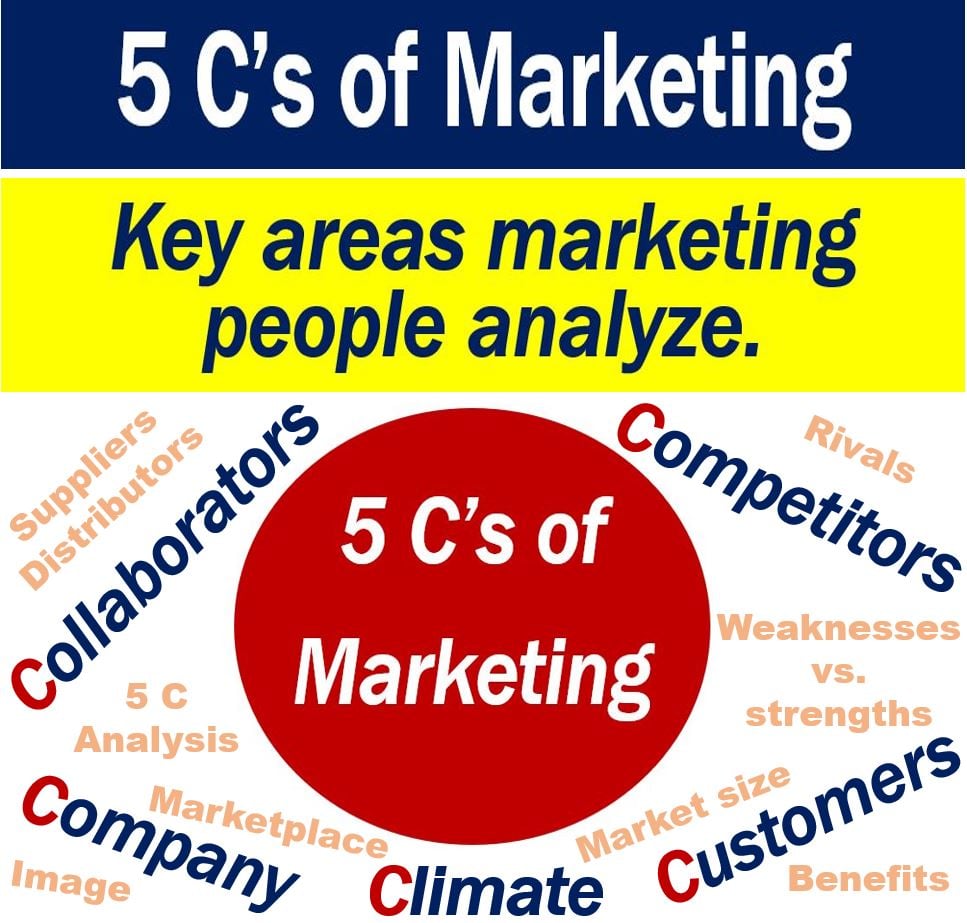The Five C’s of Marketing are the five most important areas of marketing. When marketing executives make marketing decisions, they should consider the five C’s of marketing. The five C’s stand for:
- Company,
- Customers,
- Collaborators,
- Competitors, and
- Climate.
The five C’s act as a guideline when we are creating a marketing plan or devising a marketing strategy.
A marketing strategy exists when a company combines all its goals and objectives into one plan.
The Five C’s of Marketing is an extension of the Three C’s, which just covered competitors, customers, and company.
With the advent of digital channels, the concept of ‘Content’ has informally become the sixth C, underscoring the importance of content marketing in engaging customers and differentiating a company’s brand in the digital age.

Five C’s of Marketing – importance
When trying to satisfy customer needs profitably, we must first understand our external and internal situation in the marketplace. In this context, ‘marketplace‘ means ‘market‘ in the abstract sense of the word.
We must understand the customer, the commercial environment, and our company’s capabilities. We must also be able to forecast trends in the company’s ever-changing marketplace.
This is where the 5 C Analysis is useful. It is an environmental scan of the Five C’s of Marketing which analyzes the micro-environmental and macro-environmental factors.
Micro-environmental and macro-environmental factors are internal and external factors respectively.
Five C’s of Marketing – description
As mentioned earlier, the Five C’s are Company, Collaborators, Customers, Competitors, and Climate.
Company
This involves an analysis of the company’s product line, its culture, goals and objectives, and image in the market. We also look at the company’s technology and experience.
The main aim here is to determine whether the company is in the best position to meet customer needs.
Collaborators
Collaborators are businesses or entities that can help the company achieve its goals and objectives.
Suppliers and distributors, for example, are collaborators.
Customers
It is important to identify your customers and determine which of their needs you are attempting to satisfy. What tangible and intangible benefits is the customer seeking?
To compete successfully in the marketplace, you need to know what the motivation behind your customers’ purchases is.
Possible areas of research are market size, market growth, market segments, purchasing frequency, and seasonal factors.
Competitors
Above all, you need to know who you are competing against in meeting your customers’ needs. Is the other company a potential threat or an active competitor? How many of them are there?
What are your rivals’ weaknesses and strengths? Is there anything you can do regarding those weaknesses and strengths?
Climate
When looking at climate, we are assessing macro-environmental factors, i.e., external factors. The economic environment, political environment, and regulatory environment, for example, are part of the ‘climate.’
Society’s fashions and trends, i.e., the social/cultural environment, are also part of the ‘climate.’
Examining the climate also includes analyzing the technological environment. What is the impact of technology on, for example, demand?
Some people use the term PEST Analysis when talking about analyzing the climate. PEST, in this context, stands for Political, Economic, Social, and Technological.
The analysis extends to understanding legal and environmental factors, often expanding the acronym to PESTEL, which encompasses the full spectrum of the macro-environmental climate that can affect marketing strategies.
In today’s digital era, it’s essential to consider the ethical dimension of marketing, as consumer data protection and privacy have become pivotal concerns in shaping public perception and trust.
